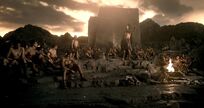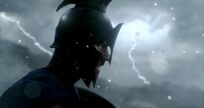Before mentioning the history, let’s summarize a few technical noises of this film: the
setting-the bay scene has not changed. All the scenery, whether it is a port or a market, is all made by CG, and no bricks and tiles are true. Muro, can you put in two real jars if you are short of money?
Hue-the sky is always a shit-like HDR, and it feels like a tuft of flying. Muro, you should learn more from the CG of the Lord of the Rings. CG can't be done well.
Costumes-the Greeks are powerful in heavy infantry, dear! Where's the armor? Where's the armor? The Greek warriors were all naked and wore a pair of underwear. The general put on a blue cape and it was done. Instead, the Persians are fully armored. Isn't this cheating! Isn't it such a way to save clothing expenses? ! ! Director, are you sure it's not to attract female audiences to show men? Only the helmet shield is consistent with historical facts.
Props-At the time, the talents of Athens were the overlords of the sea, and the shipbuilding technology was the highest. In the movie, the Athenian’s three-row oar battleship is still more similar, but the Persian’s ship is not that big, and the bow is not that terrifying.
Bloody-too bloody, every time a knife is cut, a screen of blood will be charged, which makes people feel that the director can do nothing but spray blood... the scene is too monotonous.
-------------------------------------------------- ----------------------------------------
Okay, let's start to complain about the plot.
1. The reason why Dimitocli advocated the Athenians to fight at sea. The ancients believed in God, and they had to listen to God's metaphors. When I heard that the Persians were going to attack, the Greeks were actually very hesitant. Some city-states, such as Macedonia, helped the Persians, and many other city-states were neutral (almost all of them were forcibly conquered by the Persians). In the end, the remaining Greeks were convinced that it was the Athenians who fought at sea, and it was Dimitocli's interpretation of the gods.
At that time, the Athenians asked for a metaphor, saying that the wooden wall was their solid fortress. Some people think that the wooden wall refers to a fortress on land, but Dimitocli thinks it actually refers to a three-row battleship. The god also said, "Holy salami! When you sow or harvest grain, you will destroy the children born to women." When most people thought that this heralded the defeat of the Athenians and was preparing to flee, Dimitocli said that if it was defeated, the oracle would say "tragic" instead of "sacred" Salamis. So he believed that this sentence was said from the perspective of the Persians, which meant that the Persians would be defeated miserably. The Athenians agreed with his explanation and decided to follow his leadership to fight.
2. At the beginning, remember the marathon battle. My dear, Darius was not shot to death by Di Mistocle. They fled back to Persia and died later. And the marathon is definitely a great victory. The Athenians killed 6,400 people in Persia with a loss of 192 people! The Spartans were not in the marathon at all, and they arrived after the Athenians finished their fight (they didn't want to help Athens, so they had to wait for the full moon to set off as an interface to delay time). [Herodot, Wang Yizhu Edition (the same below), P617]
3. Battle of Wenquan Pass. There was actually a shot in the movie. King Leonidas I of Sparta did indeed die in battle. However, there were not only 300 Spartan heavy infantry (although they were the main force) at Hot Spring Pass. There were also about 4,000 troops in other places. The Persians certainly claim to be an army of 100,000 (may be exaggerated). But the Spartans were fierce. They were heavily armed, well-trained, and they fought with spears. Wenquanguan is another narrow terrain with mountains on one side and the sea on the other (the scene of this movie is in line with reality). Xerxes couldn't beat it after four days. Later, there was an inner ghost, and some people took the Persians around from behind a hillside to kill the Spartans. But Xerxes lost 20,000 people. Visible the fighting power of the Spartans. If there is no inner ghost, the Spartans can last longer. [Herodot, P720]
4. Comparison of forces in the Salami naval battle. Too cheating in the movie! Do the Athenians really only have those thirty or fifty ships? joke! How could such a small ship be known as the maritime hegemon of the year. And did the Athenians really ask the Spartans to give the ship? Do the Spartans really have the same huge fleet as at the end of the movie? The director is really a master of obsession. The historical facts are not what it looks like in the movie. The Athenians obviously wanted the Spartans to go out of the army to guard Attica (where Athens is located), but the Spartans only wanted to guard their own gateway to the Isthmus of Corinth.
Herodotus’s comparison of forces between the two sides is as follows:
In the Battle of Admicillin, the
Persian side: After the storm was lost, there were about 300-600 ships; the
Greek side: The Athens Navy had a total of 251 three-row warships. . Among them, there are 127 Athenians, 40 Corinthians, 20 Megara, 20 Chalkis crews (the ship is Athens), 18 Eginas, 12 Western Zionans, There were 10 Badars, 8 Epidaurus, 7 Eritreans, 5 Troezens, 2 Styreans and Kea each; there were 9 fifty-oars warships. [Herodot, P728] In the
Battle of Salamis, the
Greek side: The Athens Navy had a total of 366 three-row warships. The main composition of the fleet is as follows: 180 Athenians, 40 Corinthians, 30 Eginas, 20 Megara, 20 Chalkis, 16 Spartans, and West Zion. 15 ships, 10 Epidaurus, 7 Ambracia, 7 Eritreans, 5 Troezen, 4 Naxos, and other sporadic ships. [Herodotus, P742-744]
So see who is the overlord of the sea. Spartans don't have so many ships at all.
5. Battle location. In order to save CG, the four sea battles were all fought in the same port. Just kidding == After the Xerxes army conquered the hot springs, the navy also entered Artemisium (Artemisium). The Persians had the advantage in this battle. But there was heavy rain on the sea at that time. As you can see from the map, the Persians sent 200 ships to make a roundabout, but they encountered a storm and all died. And the Persians couldn't swim, so they all drowned. Now the strength of both sides is almost the same. They fought for three days. On the first day, Xerxes felt that he had a lot of ships, arranged in a circular array, and packed the Greek ships in the middle. However, the Greeks killed 30 Persian ships with speed and courage, but overall the two sides did not have a decisive victory. The third day happened to be the day when the army was fighting at Hot Spring Pass. The Persians lined up in a half-moon formation, and the Greeks broke through from the middle. Both sides suffered heavy losses. After this battle, Dimistocles separated the Greeks in the Persian team and brought the fleet to Salamis. [Herodot, P728-734]
6. Battle of Salamis. The strength of the two sides is relatively close, not like in the movie. In the end, only six or seven lonely boats fought with the Persian army. The Persians were defeated because their ships were very chaotic; while the Greeks were well-trained and orderly. The Greeks did receive reinforcements before the war, but it was not the Spartans' "large fleet" at all, but two ships that had escaped from Tinos and Admicillin. [Herodot, P758]
7. Leadership of the fleet. Artemisia has its own people. She was the queen of Halicarnathos, who was an ally of Xerxes at the time, and because she was very wealthy, she had a great influence on Xerxes. But Xerxes did not rely on her to dominate. Artemisia did command on a ship, but she was only one of the commanders, not the commander-in-chief. In fact, the Persians do not have a commander-in-chief (or Xerxes is the commander-in-chief), and each tribe that sails has its own commander. The artillery scene between Artemisia and Dimitocli on the ship is even more nonsense.
8. Negotiations between Dimitocli and the Persians. The artillery scene is nonsense. But Dimitocli did secretly send an envoy to Xerxes on the first night of the battle. Because of the differences among the Greeks at that time, the Persian army was drawn to Corinth. Some people felt that they should withdraw their troops to guard the land. Others advocated fighting on the spot in Salamis. Dimistocles secretly sent people to tell the Persians that the Spartans were preparing to retreat and lure the Persians into siege, in order to force all the Greeks to fight with all their strength. [Herodot, P755]
9. Dimitocli had fornicated the Persians. This is a later story. After the Battle of Salamis, Dimystokli may be exiled by the Athenians after knowing that his reputation is too high. When Lespong retreated, he promised not to destroy the pontoon. Otherwise, all Xerxes army will be trapped on the Greek peninsula.
10. The fate of Artemisia. She was not killed by Di Mistocle at all, but she gained great honor in front of Xerxes. This matter is actually very terrible. At that time, her ship was chased by an Attica ship and could not escape. She turned back and attacked the army. The Greeks therefore thought she was their own and stopped chasing her; Xerxes saw her struggling to sink the "enemy ship". She finally escaped and survived. [Herodot, P760]
11. Fire attack. This is completely fabricated by the movie. Perhaps the director watched the Battle of Chibi ==
12. Di Mistocle’s pre-war speech. He did give a wonderful pre-war speech, but Herodotus did not record the specific speech. But the "fight for freedom" mentioned in the movie is probably not true. It is more like a speech from Pericles' funeral speech after the first year in Peloponnese. In addition, in line with the main theme of the United States.
13. Queen of Sparta. This is completely YY again, where did it come out... War is a man's business, and there will be no women on the battlefield. Artemisia is already a special case. In addition, Sparta had two kings, one died in battle and another. Dimitocli’s negotiations couldn’t talk about the Queen’s coming out... In PS, diplomacy was all carried out at the citizens’ assembly, and nothing happened to the king.
-------------------------------------------------- ----------------------------------------
Summary:
This movie is in line with historical facts Basically there are only:
the shape of the Greek three-row oar battleship; the names and positions of Dimitocli, Artemisia, and Xerxes; the helmets and shields of the Greek warriors
, all nonsense.
Don't believe that what is filmed in the movie is history.
View more about 300: Rise of an Empire reviews











